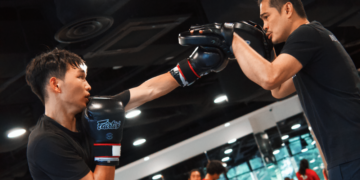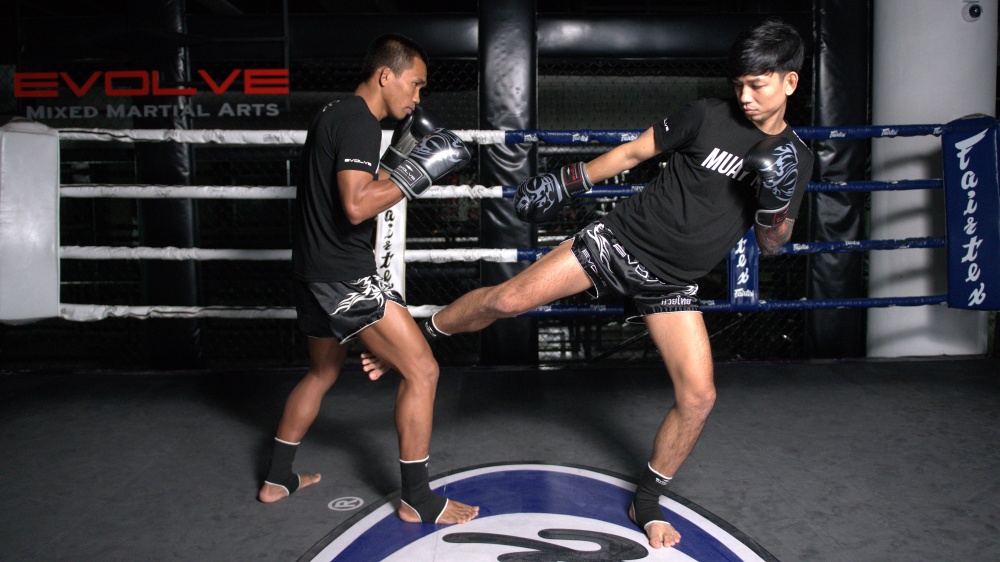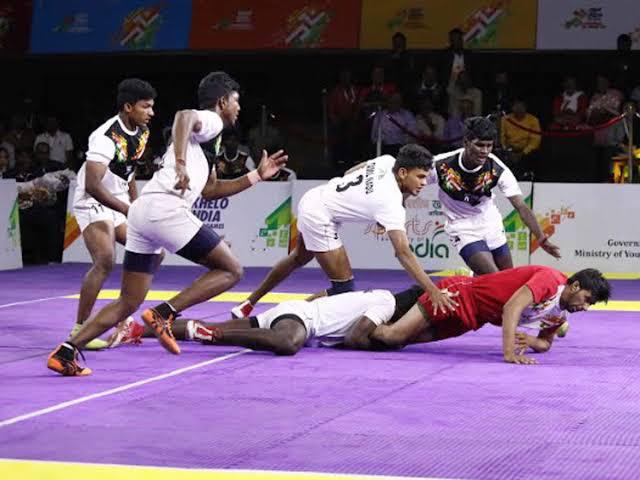Everyone who’s been training Muay Thai for more than a few months knows that fighting against a southpaw fighter is a headache. Your opponent moves the wrong way, your favorite techniques fail to land cleanly, and their strikes seem to come at you backward, making them hard to defend. Worse yet, they only make up ten percent of the population, so if you’re matched to fight a dreaded southpaw it can be a tall order to find a lefty to practice with.
Believe it or not, fighting a southpaw is a simple process. It only takes three steps to maximize your effectiveness and nullify their damaging left kicks. If you are an orthodox fighter matched against a southpaw, or you are simply sick of your left-handed teammate getting the best of you in sparring, read on. This article will give you all you need to enter the ring against a dreaded southpaw and come out with your hand raised.
1) Circling To Your Lead Side
Circling off to your left-hand side is the first step to follow. It is also the most important because as you will soon see, in a battle between fighters of opposing stances, the fighter with their lead foot on the outside has the upper hand. In fact, you’ll make the two steps that follow incredibly difficult unless you make circling off to your lead side muscle memory.
By having your lead foot on the outside of your opponents it brings your right-sided power shots into a closer range to strike. Your right kicks don’t have to travel as far, giving less time for your left-handed adversary to react and defend against them. Also, it brings your straight right hand and stabbing rear knee in line with the center of your opponent’s body, making it easy to throw them straight through the middle of your opponent’s guard.
Any southpaw with sense will know they are at a disadvantage with their lead foot inside yours, so it is important to keep stepping left. You can hide this movement by throwing a stiff jab into their face or pivoting off with a lead hook.
Southpaw and Muay Thai legend, Yodsanklai Fairtex, demonstrates the importance of having your lead foot to the outside of an alternating stance exchange in this fight against Kickboxer, Andy Souwer.
Notice the way Yodsanklai creeps forward and right as he stalks Souwer across the cage. It sets him up for the devastating left hands that he used to finish the fight in the second round. Alternatively, Souwer made the error of circling toward Yodsanklai’s power side, and you can see the ease with which he was able to cover or avoid Souwer’s high right kicks each time he threw them.
2) Throw Everything From Your Right
As mentioned in step 1, having your lead foot to the outside of a southpaw opponent maximizes the effectiveness of your power, the right side. Whilst you can still use your lead jab to distract your opponent and a left hook to change angles, the use of your remaining left-sided weapons will be severely restricted. If your right straights are primed to fire on a southpaw’s central mass, then left-sided weapons such as teeps and knees are likely to fly directly under your opponent’s lead armpit.
Also, the orthodox vs southpaw body mechanics make it so your left kicks become difficult to land. In order to chop a lead leg, you need to bring yourself into close range and the act of switching your stance slows the strike making you susceptible to punches before the kick lands. It is much safer to wait for them to step forward so you can boot their inner thigh with your rear leg. Whilst the angle of a southpaw’s body makes it difficult to get your shin to their ribs without your leg getting caught.
That is why you don’t see a single switch body kick in this mixed stance fight between high-level fighters Liam Harrison and Petchmorakot Petchyindee. Harrison has a lot of success with his inside right leg kick but when he throws a single switch leg kick in the first round it is easily blocked.
3) Negate The Left Kick
Southpaws train and train (and train again) their left kick until it becomes their primary weapon. So, if you’re training to fight a southpaw, then it’s important to drill ways to turn that weapon into a weakness.
By being aware that they are always looking to land their left kick you can begin predicting when they will use it. Many southpaws will use a lead jab or hook to disguise the outside step they will use to set up their kick, so whenever you notice your opponent doing this, it is safe to assume a left kick will follow. This is easier said than done, especially if you are fighting an experienced southpaw. If you struggle with this then ensure you keep your lead foot outside of theirs so you have more time to react to their left kick when it is inevitably thrown.
From the outside position, you can do as Yodsanklai did in the first video, leaning back when they throw the kick high before countering. Or you can be like Harrison in the earlier video. You’ll notice his catch and sweep in the opening round occurs when Petchmorakot kicked while his lead leg was on the inside position, giving Harrison more time to respond.
Harrison also made a habit of kicking Petchmorakot’s inner thigh whenever he stepped forward which would have slowed the Thai’s kicks and reduced their power if he was able to continue doing so for the entire fight. These thigh kicks, commonly known as inside leg kicks, can be even more devastating if you time them as your opponent postures up to throw their rear kick. This timing can potentially take their leg out from under them. Doing so is a risky maneuver (and difficult to time), so it is best to save this for later in the fight when consecutive leg kicks have already slowed your opponent down.
Finally, as your opponent moves off-centre, they will bring your lead leg in line with their center mass, making it easier to land a well-timed teep as they come up onto one leg. Former ONE Championship Muay Thai World Champion Nong-O demonstrates a variation of this above, disrupting a southpaw’s kick with a low teep before following up with strikes of his own.
Conclusion
The three steps above are all you’ll need to beat a southpaw fighter. That being said, don’t make the mistake of thinking that because they are simple in theory, they’ll be easy to do when you’re in the ring. Everything that works against a southpaw can be done in reverse and used against you. Left-handed fighters have been trained from their very first session to circle to their right, to execute devastating left-sided strikes, and negate your best orthodox weapons. You’ll need to drill all of these steps consistently in every single session if you plan on beating them at their own game. In fact, if you are an orthodox fighter you should begin drilling these steps regularly even if you aren’t matched to fight a southpaw any time soon.
You may also like:
How To Prepare For Your First Muay Thai Fight Or Competition
Clinching is a fundamental part of Muay Thai. Its brutal nature makes the art of eight limbs stand out from other combat sports and if you can’t clinch then you will find yourself at the…
Punching is an integral part of any combat sport, whether it’s Boxing, Kickboxing, Muay Thai, or MMA. The ability to land powerful punches is essential for any combat athlete. Even if you are primarily a…
In the world of Muay Thai, counter fighters are revered for their exceptional defensive prowess and impeccable timing. Some of these skilled practitioners possess the ability to exploit their opponent’s mistakes and capitalize on openings…
The elbow strike is a brutal short-range weapon used in Muay Thai. The force and damage that can be inflicted can be devastating and the results can quickly end a fight. Elbow strikes pack a…
In Muay Thai, fighters look for ways to enhance their defensive capabilities and maintain control over their opponents. One such technique that has gained significant recognition is the knee guard. The knee guard is a…
In the world of Muay Thai, developing fluid and effective striking combinations is crucial for success. It’s not only about rehearsing and throwing the same combos over and over, you will need to develop over…
In the world of martial arts, where power, agility, and precision are crucial, rotational exercises have emerged as a key component of an effective training regimen. These exercises, which involve rotating the body or parts…
Muay Thai is a sport that has grown exponentially over the past few years. The increase in social media exposure from Thailand’s largest stadiums as well as global promotions such as ONE Championship, Muay Thai…
In the heart of a bustling metropolis like Singapore, companies are progressively acknowledging the integral role of employee wellness in a thriving workplace. This transformation is palpable as companies are taking various innovative measures to…
Brazilian Jiu-Jitsu is widely viewed to be one of the most effective martial arts in the world, and it comes with a rich history and culture. It’s a grappling-based martial art that was developed by…
Boxing is perhaps the purest form of combat known to man. Nothing could be simpler than duking it out with nothing but the hands. Despite its inherent simplicity, there are several different styles and tactics…
The martial arts of Muay Thai and Lethwei are deeply ingrained into the history and national identity of the neighbouring countries, Thailand and Myanmar (formerly Burma) respectively. The fact that these countries share a border…





































